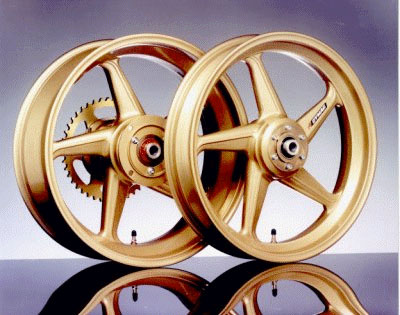Surface treatments for magnesium
 In a previous article, I discussed some of the merits of using magnesium alloys in race engines. This isn't an original train of thought; the use of magnesium was widespread in different forms of motor racing more than 50 years ago, and the car and motorcycle manufacturers embrace it willingly in an effort to reduce engine and vehicle mass. Indeed, it has been common to use magnesium covers - cam covers, for example - on production motorcycles for decades now.
In a previous article, I discussed some of the merits of using magnesium alloys in race engines. This isn't an original train of thought; the use of magnesium was widespread in different forms of motor racing more than 50 years ago, and the car and motorcycle manufacturers embrace it willingly in an effort to reduce engine and vehicle mass. Indeed, it has been common to use magnesium covers - cam covers, for example - on production motorcycles for decades now.
With a density of 1.74g/cm3 compared to 2.7g/cm3 for aluminium, it is easy to see why magnesium is an attractive proposition for car and motorcycle makers. Given magnesium's advantages, the reasons why some race series regulations choose to legislate against its use aren't clear.
In the production car world, BMW for example now uses magnesium not only for lightweight covers but for cylinder blocks too, using a very clever production process that sees all surfaces in contact with the coolant being made from a less easily corroded aluminium alloy. The reason for using aluminium is the behaviour of magnesium when a corrosive medium or electrolyte is present. Without protection, magnesium tarnishes and corrodes rapidly.
This is the main reason why, in the aerospace industry, where magnesium is widely used, it is almost always found in the painted condition. This is the most basic (yet one of the most effective) anti-corrosion treatments. The magnesium parts generally undergo a chromate treatment before painting. The treatment can offer a little protection against corrosion, but its main purpose in this instance is to act as an 'undercoat' for the paint.
With processes based on chromium judged to be bad for the environment, other pre-treatments are available. One such passivation treatment (a treatment which makes the surface less prone to corrode) is based on using the natural behaviour of the surface in terms of oxidation, combined with other metal oxides, particularly manganese oxide, to form a corrosion-resistant layer. As with chromate treatment, this process offers some basic corrosion resistance but this is greatly enhanced by painting or sealing. Epoxy resins are an example of a sealing compound often used for this purpose.
In addition to painting, powder coating is another process widely used for protecting magnesium parts, and is much beloved of those restoring magnesium wheels and so on.

Anodising magnesium for corrosion protection and to act as an undercoat for subsequent processes isn't new, with two widely used processes having been available for more than 60 years. However, these processes leave a porous oxide film which is far from perfect when corrosion prevention is concerned, so parts thus coated will generally require painting or sealing.
In recent years there have been a number of arc-assisted anodising processes that allow the build-up of hard and thick anodic films of magnesium oxide on the surface of components. Whereas painting offers an attractive and corrosion-resistant appearance, we can't depend on the dimensional accuracy of the process, nor can we hope to use the surface in a functional sense - we couldn't rely on the paint layer to support any load, for example where we use threaded fasteners.
These plasma electrolytic oxidation processes produce a surface that is far less porous than the older anodising processes. There is an outer layer of porous oxide, but below this there is a far more tightly packed and amorphous layer. The surfaces thus produced are far more corrosion resistant than the older processes, and because they don't necessarily need to be painted or sealed afterwards, they can be used to support load.
Fig. 1 - These magnesium motorcycle wheels need multiple surface treatments to ensure they remain in good condition
Written by Wayne Ward